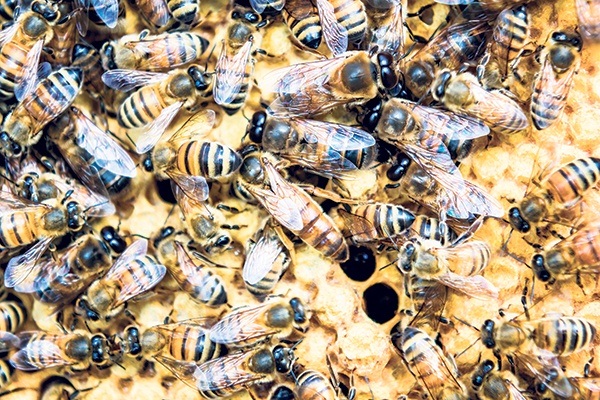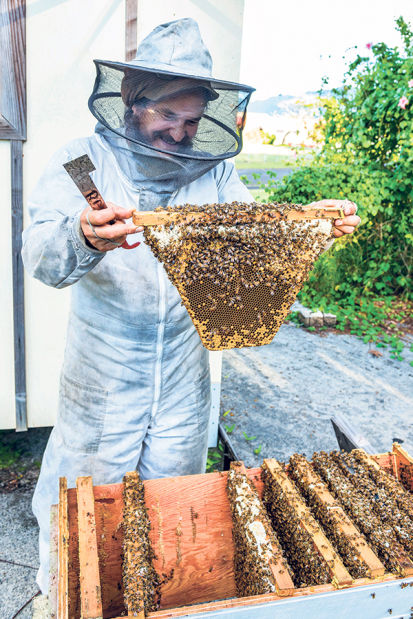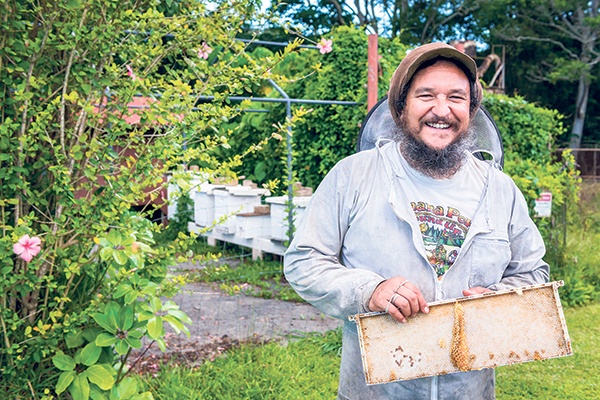James Trujillo is the instructor for the apiary program at Kauai Community College and president of the Kauai Beekeepers Association. This year, Trujillo will teach four workshops at KCC: Introduction to Beekeeping, Hive Split and Swarm Recovery, Honey Harvesting and
James Trujillo is the instructor for the apiary program at Kauai Community College and president of the Kauai Beekeepers Association. This year, Trujillo will teach four workshops at KCC: Introduction to Beekeeping, Hive Split and Swarm Recovery, Honey Harvesting and Wax Processing, and Box Building.
Honeybees
Honeybees, America’s most efficient pollinator, are in decline. About 33 percent of what we eat comes from plants pollinated by honeybees. If we lose honeybees, our diet will become less diverse and more expensive. Even milk would become scarce, because protein-rich alfalfa, which is a dairy cow’s diet, needs pollinators to produce seed.
Each year, America loses about 30 percent of the bee population. The three biggest causes are synthetic pesticides, varroa mites and poor nutrition. Pesticide use is pervasive in agriculture as well as in homes, shopping malls, resorts and golf courses. As land is developed, bees are having a harder time finding food.
Varroa mite and small hive beetles are common beehive pests. Mites attach to the bee’s body, suck vital fluids and eventually kill the bee. Small hive beetles damage the comb, stored honey and pollen and may cause bees to abandon their hive. Trujillo controls small hive beetle populations by filling plastic trays with vegetable oil and placing it in the hive.
“Hawaii’s honey production is small,” says Trujillo, “but we’ve had visiting entomologists and apiarists say Kauai has some of the healthiest bees in the world. Primarily, it’s because of a lack of widespread agricultural practices that rely on chemicals. We’re very different than say, Chico, California, which is surrounded by heavy industrial ag. And we don’t have varroa mite.”
Bee friendly
Buying local honey supports beekeepers and requires the least amount of carbon to get to your table. Consuming honey sourced close to your home helps to alleviate allergies. Reduce use of synthetic pesticides and other harmful chemicals by buying organic when possible.
Plant a diverse bee-friendly garden that includes herbs, vegetables and trees. Bees happily tuck into flowers from mint, sage, oregano, basil, thyme and parsley. Beneficial vegetables include sweet potatoes, melons, cucumbers, peppers, tomatillos, chayote and pumpkins. Favorite trees include lychee, mango, palms, avocado and citrus.
Bees (and butterflies) seek nutrition from the nectar and pollen of flowers, but not all flowers are nutritionally profitable. Petal structure can inhibit pollinators from consuming nectar or collecting pollen. Preferable flowers include daisy, short corolla, gerbera, sunflowers and buckwheat. Native flowers, which feed bees that are uniquely adapted to Kauai, include Lantana, Ohi a lehua, Naupaka, Ilima and False heather. Protect native forests by purchasing plants from a nursery.
Season: Bees make honey from late May through late July. During this time, hives are filled with honey, which displaces brooding space. In a quest for a roomier home, bees and their queen leave the hive in a swarm. They have gorged on honey and are very unlikely to sting.
“People are always afraid of swarms,” says Trujillo. “But the bees are docile and drunk on honey. If you have a swarm, don’t panic and don’t spray. Call a beekeeper.”
Tip
Trujillo says honeybees are not inclined to bite because they die. Stingers are attached to two glands, which produce venom. When a stinger shoots out, a barb holds to its target and separates the bee from its guts. Worker bees, which are female and gather honey, use stingers just for defense.
Honeybees sting when they feel threatened. Much like humans, foul odors, vibrations and high-frequency sounds such as weed wackers and tractors aggravate bees. If you do get stung, scrape the stinger because squeezing the sac to pull it out may push remaining venom into the wound. People react differently.
The day before our interview, Trujillo got stung 12 times on his chin while collecting honey. I couldn’t tell. Some people get a large, hard, red bump surrounding the site of the sting.
Sometimes, there is swelling several inches surrounding the area. Ice, elevation and allergy medication will alleviate pain and swelling.
Some people have an allergic reaction and will go into anaphylactic shock within 20 minutes. Symptoms include dizziness, loss of consciousness, labored breathing, swelling of the tongue and breathing tubes, blueness of skin, low blood pressure, heart failure and death. Immediate emergency treatment is needed, including administration of epinephrine.
Taste of honey
Honey has a terrior of its own. Much like wine or chocolate, it takes on characteristics of a place, or in honey’s case, a flower. Kauai’s bees love Albizia trees and the honey, which is available from KBA, tastes bright and citrus-y.
Preparation
Honey can be used as an alternative to sugar when sweetening bakes goods, tea, coffee and smoothies. Honey pairs well with almonds, apples, apricots, bananas, carrots, coconut, figs, ginger, grapefruit, guava, kumquats, lavender, citrus, melons, papayas, pineapple and dairy products. Excellent honey combinations include almonds, chicken and pomegranate; bananas, lavender and pork; fruit and yogurt.
KCC’s honey can be found at
Kauai Beekeepers Association sells honey at the Kauai Community Market (Saturdays 9:30 a.m. to 1 p.m.) at Kauai Community College. For workshop information and registration, call 245-8318. For more information on the Kauai Beekeepers Association, email Jimmy at jtrujill@hawaii.edu.
• • •
Marta Lane, a food writer on Kauai since 2010, offers farm to fork food tours and is the author of Tasting Kauai: Restaurants – From Food Trucks to Fine Dining, A Guide to Eating Well on the Garden Island. For more information, visit TastingKauai.com.




